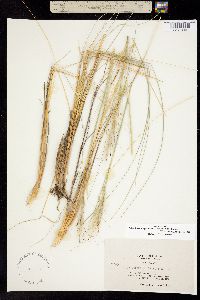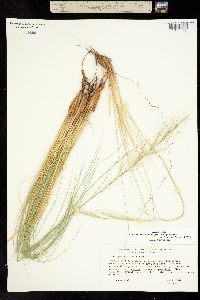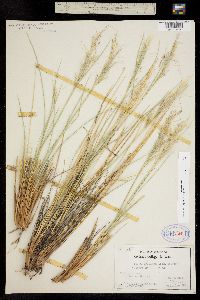Pappostipa speciosa
|
|
|
|
Family: Poaceae
Desert Needle Grass, more...desert needlegrass
[Achnatherum speciosum (Trin. & Rupr.) Barkworth, moreStipa humilis var. speciosa (Trin. & Rupr.) Kuntze, Stipa speciosa Trin. & Rupr., Stipa speciosa f. minor Speg., Stipa speciosa f. speciosa Trin. & Rupr., Stipa speciosa var. minor Vasey, Stipa tehuelches Speg.] |
Dr. David Bogler, USDA NRCS PLANTS Database Perennials, Terrestrial, not aquatic, Stems nodes swollen or brittle, Stems erect or ascending, Stems caespitose, tufted, or clustered, Stems terete, round in cross section, or polygonal, Stem internodes hollow, Stems with inflorescence less than 1 m tall, Basal leaves equal to or exceeding stems, culms, or scapes, Stems, culms, or scapes exceeding basal leaves, Leaves mostly basal, below middle of stem, Leaves conspicuously 2-ranked, distichous, Leaves sheathing at base, Leaf sheath mostly open, or loose, Leaf sheath smooth, glabrous, Leaf sheath hairy at summit, throat, or collar, Leaf sheath and blade differentiated, Leaf blades linear, Leaf blades very nar row or filiform, less than 2 mm wide, Leaf blade margins folded, involute, or conduplicate, Leaf blades mostly glabrous, Leaf blades more or less hairy, Ligule present, Ligule an unfringed eciliate membrane, Inflorescence terminal, Inflorescence a contracted panicle, narrowly paniculate, branches appressed or ascending, Inflorescence solitary, with 1 spike, fascicle, glomerule, head, or cluster per stem or culm, Flowers bisexual, Spikelets pedicellate, Spikelets laterally compressed, Spikelets dorsally compressed or terete, Inflorescence or spikelets partially hidden in leaf sheaths, subtended by spatheole, Spikelet less than 3 mm wide, Spikelets with 1 fertile floret, Spikelets solitary at rachis nodes, Spikelets all alike and fertille, Spikelets bisexual, Spikelets disarticulating above the glumes, glumes persistent, Spikelets disarticulating beneath or between the florets, Spikelets conspicuously hairy , Rachilla or pedicel glabrous, Glumes present, empty bracts, Glumes 2 clearly present, Glumes distinctly unequal, Glumes equal to or longer than adjacent lemma, Glumes 1 nerved, Glumes 3 nerved, Lemma coriaceous, firmer or thicker in texture than the glumes, Lemma 5-7 nerved, Lemma body or surface hairy, Lemma apex dentate, 2-fid, Lemma distinctly awned, more than 2-3 mm, Lemma with 1 awn, Lemma awn 2-4 cm long or longer, Lemma awn from sinus of bifid apex, Lemma awn twisted, spirally coiled at base, like a corkscrew, Lemma awn once geniculate, bent once, Lemma margins inrolled, tightly covering palea and caryopsis, Lemma straight, Callus or base of lemma evidently hairy, Callus hairs shorter than lemma, Lemma surface pilose, setose or bristly, Palea present, well developed, Palea membranous, hyaline, Palea shorter than lemma, Stamens 3, Styles 2-fid, deeply 2-branched, Stigmas 2, Fruit - caryopsis Gould 1980, Hitchcock 1971, FNA 2006 Common Name: desert needlegrass Duration: Perennial Nativity: Native Lifeform: Graminoid General: Perennial grass, 30-60 cm tall; stems firm, erect, in dense clumps. Vegetative: Sheaths rounded, smooth or occasionally pubescent, short-ciliate on the margins near the collar; lowermost sheaths shiny and persistent on old stems after blades weather off; blades firm, tightly involute and 15-30 cm long; ligules short, densely short-ciliate. Inflorescence: Dense contracted panicle, often partially included in upper sheath and not extending far above blades, 6-15 cm long; glumes subequal, 15 mm long, hyaline and membranous on tips and margins, with a strong midnerve and 2-4 weak or short lateral nerves; lemma 7-10 mm long, uniformly short-pubescent on body, with slightly longer and stiffer hairs on callus, long-awned; awn sharply once-geniculate; lower awn segment 1-2 cm long, tightly twisted, and plumose with hairs 4-8 mm long; upper awn segment mostly 1.5-2.5 cm long, glabrous or scaberulous, and not or very slightly twisted. Ecology: Found on rocky or sandy soils, slopes and flats from 2,000-6,000 ft (610-1829 m); flowers March-June. Distribution: sw US in CA, NV, AZ, UT, CO and NM; south to n MEX; also in S. Amer. Notes: Similar to other species in the Stipa group, with its very long awns. Look for the distinctive tuft of hairs at the base of the awn, and the twist and bend to the awn. Also distinguished by the long lemma body, and by the plant-s growth form in dense clumps with tightly involute blades. It could be confused with Bothriochloa barbinodis, which also has hairy seeds and long bent awns. However, the panicles of B. barbinodis are usually composed of many spikes, all attached to the grass at about the same place (i.e. subdigitately arranged) and the awns are much shorter and finer, at 20-35 mm long. Ethnobotany: The seeds were gathered and used for mush. Etymology: Pappostipa from the Greek pappos (down or fluff) and stipa, an old world grass genus named for the Greek word for rope or fiber; speciosa means showy. Synonyms: Achnatherum speciosum, Stipa speciosa, Jarava speciosa Editor: SBuckley 2010, AHazelton 2015 |
|
|
|

































































































